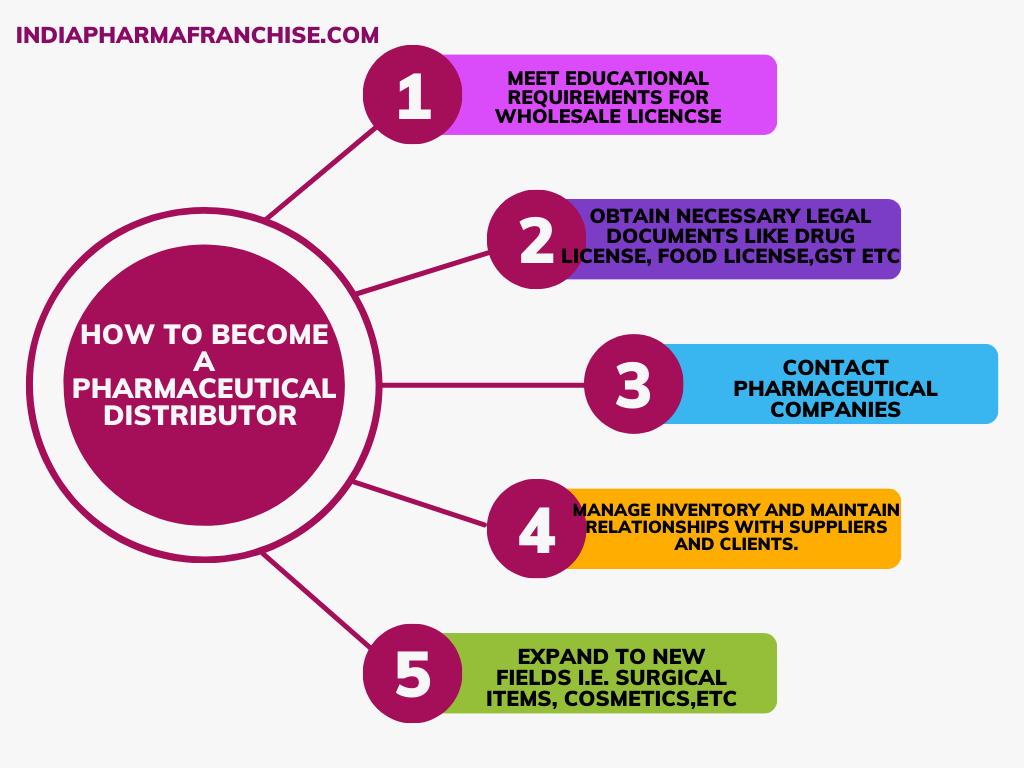Pharmaceutical Distributor in India: How to Launch & Succeed
If you are from the medical field, you must be familiar with pharmaceutical distributors; even if you are not, you must have heard about pharmaceutical distributors at some point in time. And have you ever wondered if becoming a pharmaceutical distributor in India is a good opportunity? The answer is yes!
And the reason for this is that India’s healthcare is constantly growing, and it is a recession-proof sector. This role – being a distributor – is always high volume and low margin and puts you in an industry that requires a substantial initial investment, but can be highly profitable with the right approach.
Follow these Simple steps to become a successful pharmaceutical distributor in India.
Step 1: Understand the Market Demand
Market Research
• Assess Local Demand
• Identify Target Customers
• Analyze Competitor
Choose Product Range and Specialization
• Choosing the Right Product Categories:
• Balancing Stock
Step 2: Legal Requirements (Necessary Registrations and License’s)
• Get a Wholesale Drug License
• GST Registration
• Business Registration
• Obtain a Food License from FSSAI for Nutraceuticals
Step 3: Infrastructure Setup
• Warehouse and Storage
• Cold Chain Logistics
• Inventory Management System
• Logistics and Transport
• Staff Training
Step 4: Establishing a Pharmaceutical Brand Network
• Determine Important Pharmaceutical Brands
• Approach Pharmaceutical Brands for Distributorship
• Discuss the Distributorship Terms
• Establish and Preserve Solid Connections
• Expand Your Brand Collaborations
Let’s Explain each steps one by one..

Step 1: Understand the Market Demand

The First step of any business is understanding the Market Demand and whether you would be able to compete and sustain in that market. So Before even investing you need to follow this step.
Step 3: Infrastructure Setup
Operating a pharmaceutical distribution company that is both efficient and compliant requires a strong infrastructure. This include setting up inventory, distribution, and storage systems to preserve product quality and effectively complete orders.Also this step will also take a big chunk of your Finacial investments and hence needs to be executed carefully
1. Warehouse and Storage
- Location & Conditions:
Choose a central/Pharma Hub loaction for easy access. Ensure your warehouse has temperature and humidity controls, especially for sensitive drugs like vaccines, to prevent product degradation. - Security:
Install CCTV, alarms, and restricted access to safeguard products.
2. Cold Chain Logistics:
For temperature-sensitive items, use refrigerated storage and transport solutions. Implement monitoring systems to maintain required conditions throughout storage and delivery.Intially it would be better to not jump into it simultaneosly as it a heavy investment and specialized distribution field.
3. Inventory Management System
An inventory system tailored to pharmaceuticals will help track stock, expiration dates, and batch numbers, ensuring compliance and reducing waste. Consider barcoding or RFID for better accuracy and quick retrieval.Common used Software in Pharma Distributuion is Marg Software , you may search and contact local vendor.
4. Logistics and Transport
- Own or Outsourced:
Decide on using an in-house fleet or third-party logistics for cost and control. To compete in India having own Workforce in the long run would be necessary.
5. Staff Training
Employ competent employees and teach them in GDP-compliant handling and storage of medications. Operations run smoothly and legally when staff members are trained in safety procedures.
Summary
A reliable infrastructure ensures safe storage, efficient logistics, and strong compliance, helping build a reputable, dependable pharma distribution business.And also builds trust in you clients.
Step 4: Establishing a Pharmaceutical Brand Network
Establishing a strong network with pharmaceutical companies is essential to your distributor success. To make sure you can provide in-demand products and expand your firm, this phase entails finding trustworthy pharmaceutical brands, obtaining distribution rights, negotiating conditions, and upholding solid professional partnerships.
1. Determine Important Pharmaceutical Brands
Finding the most respectable and pertinent pharmaceutical brands that fit the product categories you wish to offer should be your first step. Take into account elements such as product variety, market demand, and brand repute.
2. Approach Pharmaceutical Brands for Distributorship
Once appropriate pharmaceutical brands have been found, get in touch with them to get distributorship rights. The majority of well-known brands have official procedures in place for selecting distributors. To find out about distributorship prospects, get in touch with these brands’ sales or business development departments.
Brands may need to meet specific eligibility conditions, such as having a current wholesale drug license, suitable storage facilities, and sufficient funding to guarantee on-time orders.
How to Apply:
Send in a formal application with details about your company’s operations, distribution capabilities, and coverage area. Additionally, you might be asked to submit references from previous employers.
3. Discuss the Distributorship Terms
Negotiating the distributorship’s terms comes next once a brand accepts your application. Running a successful distribution business requires having advantageous conditions.
Pricing Structure: Work out a pricing plan that gives you a healthy margin of profit. Certain companies could provide volume-based tiered pricing, which might result in better prices as your sales increase.
Credit Period: Choose terms for credit based on your cash flow requirements. Credit periods from 15 to 60 days are frequently offered by brands, enabling you to sell goods before payment is required.
Minimum Order Quantities: Verify that the brand’s minimum order quantities (MOQs) are appropriate for your target market. Overstocking and waste can result from placing excessive orders, particularly for products with expiration dates.
Exclusivity agreements: Exclusivity agreements might be advantageous because they lessen competition in your area. Some brands may grant exclusive distributorship rights for particular regions.
4. Establish and Preserve Solid Connections
Building solid, long-lasting relationships with pharmaceutical companies is crucial for mutual company growth and reliable supply.
Communication: Discuss order fulfillment, product performance, and any emerging difficulties with the brand’s representatives on a regular basis. Open communication preserves confidence and facilitates prompt problem solving.
Reporting on sales and performance:
Update the brand on sales results on a frequent basis. Because brands may provide incentives or prizes to distributors who meet or surpass goals, this can serve to fortify your partnership.
Loyalty Programs: Long-term distributors of certain pharmaceutical brands are eligible for loyalty programs or rewards. These could give you a competitive edge and include rebates, volume discounts, or first access to new products.
5. Expand Your Brand Collaborations
Building ties with well-known pharmaceutical companies is crucial, but you should also collaborate with a variety of brands to diversify your business. It can be dangerous to rely too much on one brand in the event of price rises, policy changes, or supply chain problems.
Expand Product Offering: Collaborate with other pharmaceutical companies to provide a range of medications, such as over-the-counter (OTC) items, prescription drugs, and specialty treatments. This diversity can boost sales and draw in a larger clientele.
Equilibrium Well-known and Up-and-Coming businesses: Take into account collaborating with both established and up-and-coming pharmaceutical businesses. While newer brands could provide more flexible terms or innovative products, established brands bring credibility.
Summary
Making connections with pharmaceutical companies is one of the most crucial elements in launching a profitable distribution business. By researching well-known brands, securing a distributorship, negotiating favorable conditions, and building strong relationships, you can ensure a steady supply of products that meet consumer demand. By lowering risks and expanding your product offerings, broadening your brand alliances in the pharmaceutical distribution industry can lead to growth and profitability.


22/01/2025 @ 8:15 PM
Nice, insightful article.
22/01/2025 @ 8:18 PM
Very Nice insightful Article, will be helpful for many.